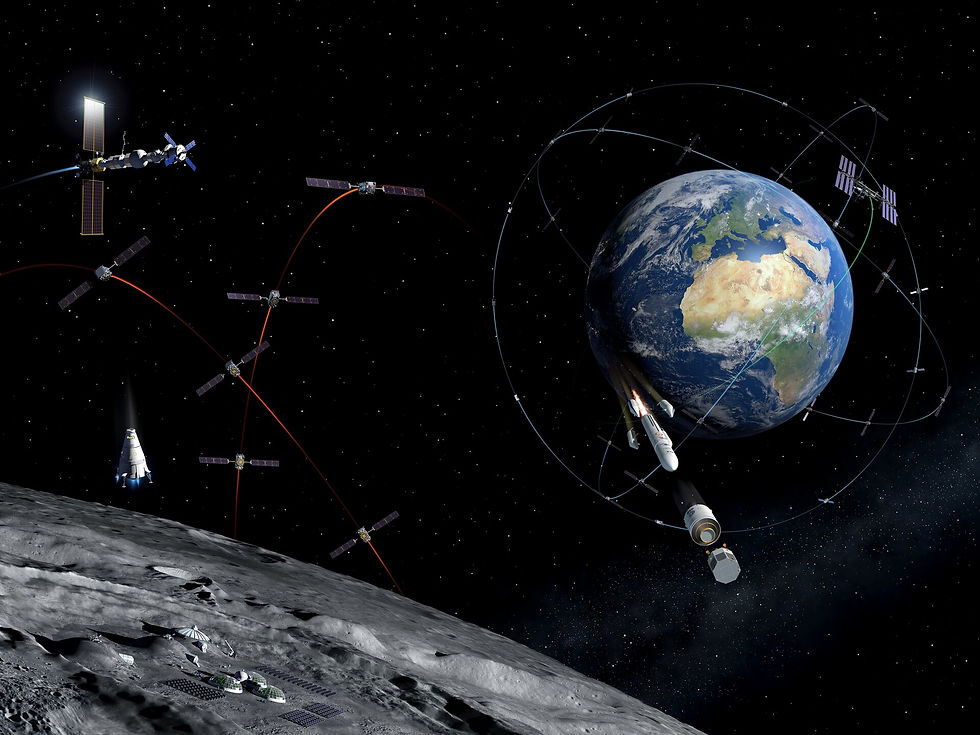Interplanetary Stepping Stones
- Webmaster
- Oct 18, 2020
- 4 min read
Updated: Mar 20, 2021
A Permanent Presence
As part of the Space Race, in 1971 the USSR started what has now progressed into a feat of scientific cooperation not seen on Earth. This was Salyut 1 (Салют-1 in Russian, meaning “Salute” or “Fireworks” [1]), made of 4 compartments (2 pressurised and 1 unpressurised), designed to for the first residents of outer space to reside, using the now famous Soyuz (Союз in Russian, meaning Union [2]) to go to and from the craft [3].
It was a snug home for the cosmonauts who ventured inside, but with all the amenities needed to survive, from a dining area to an exercise area, it was like an inescapable campervan for 3, but in space. However, there were also problems, like the risk of death from the sometimes toxic air or sudden depressurisation in the Soyuz, and the hatch to the Salyut not opening. In fact, even the orbit of the space craft could not be maintained long enough, with it being de-orbited just 2 years after being put in to space [4]!
However, this was just the start of a long journey of exploration, human ingenuity and science when it comes to creating a population of humans not residing on this rock we have been on for millennia.

A model of Soyuz docking Salyut 1. Credit: NASA/David S. F. Portree
A Building in Space
Mir (Мир in Russian meaning “world”, “peace” and “village”) [5] was the successor to the Salyut series of space stations, with the first module launched in 1986, staying up there for 15 years.
It was modular in its makeup, not unlike the current ISS, apart from: its size, being 13.1 metres in length (a home not for the claustrophobic!) [6], its smell, being “a bit like an oily garage” (FOAL Michael, 2016), the disorganisation of it all, like “going into the oesophagus of someone’s throat” (FOAL Michael, 2016), and the sound, being of Russian disco music! So, maybe it was more like a home than you might expect!
There was only one problem (apart from the smell, sight, and sound): the money. The Russian space agency, Roscosmos, was in disrepair after the fall of the USSR, and even with help from NASA, it was still a piece of old metal in space getting older by the day, and with technology improving so fast during that time, it was becoming far out-dated, leading, even to problems with the docking of its cargo ships, since they didn’t have enough money for automatic docking [7].

Mir as seen from Space Shuttle Endeavour in 1998. Credit: NASA
Truly International
The ISS (International Space Station) is a joint operation of 15 countries, started in 1998 and continuously occupied since late 2000. Like all space stations before it, it conducted, and is still conducting, countless scientific experiments to better our understanding of how things work in microgravity, from human bodies to espresso machines! However, it is much bigger, hosting not 13.1 metres of length like in Mir, but the size of a Boeing 747 (with the ISS being 109 metres long [10], ~8x longer than Mir) [8].
This venture will then aid us to make another step beyond our Earth’s orbit, to one around the Moon, to maybe even one around another planet, meaning we can then become a truly interplanetary species.

ISS after the undocking of the STS-132. Credit: NASA/Crew of STS-132
Not of this Earth
The most recent proposal of a home out of this world (literally) is Lunar Gateway. It will be the first station to orbit another body other than the Earth, and will be supported not only by other nations, but private companies as well.
Part of NASA’s Artemis program, its aim is as the name suggests: a gateway for astronauts en route to the Moon, and even a place to train NASA astronauts for missions to Mars. However, all the design of this station could not have been carried out without the help of past space stations, and what problems they encountered. Along with NASA, the Canadian Space Agency (CSA), Japanese space agency (JAXA), and ESA, have been inputting into its development, with Roscosmos having expressed interest in the venture [9]
All these space stations have been true stepping stones to a life not bolted to Earth but only bound by our technology and how long we can survive away from others. Maybe one day, we will even have one orbiting another planet. I suppose we shall just have to wait and see!

Lunar Gateway Concept Art. Credit: NASA
By George Abraham, ADAS member
Click here for the previous news article
Click here for the next news article
Click here for NASA's 'Spot the Station' tool (along with many more useful tools, like observing weather and solar activity), so you can be in with the chance of seeing the most recent space station of them all: the ISS.
References
"Салют". OpenRussian.org. Archived from the original on 18th October 2020.
"Союз". OpenRussian.org. Archived from the original on 18th October 2020.
"Salyut 1: The First Space Station". Space.com. Archived from the original on 18th October 2020.
"Salyut 1". AerospaceGuide.net. Archived from the original on 18th October 2020.
"Mir Space Station". NASA. Archived from the original on 18th October 2020.
"Mir Space Station: Testing Long-Term Stays in Space". Space.com. Archived from the original on 18th October 2020.
"A Space Crash". BBC Witness History. Archived from the original on 18th October 2020.
"International Space Station: Facts, History & Tracking". Space.com. Archived from the original on 18th October 2020.
"Gateway". NASA. Archived from the original on 18th October 2020.
"International Space Station". NASA. Archived from the original on 18th October 2020.









Comments